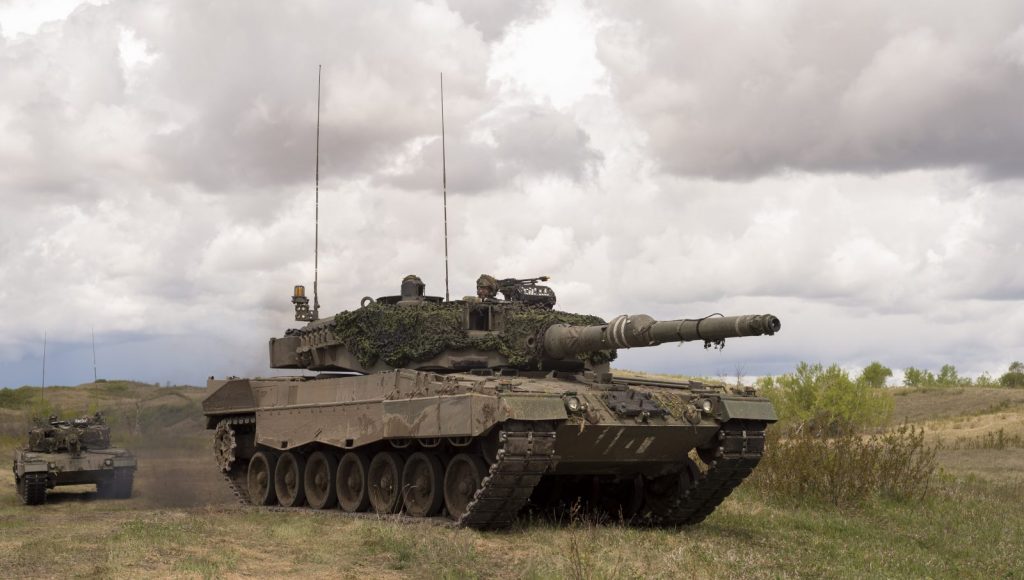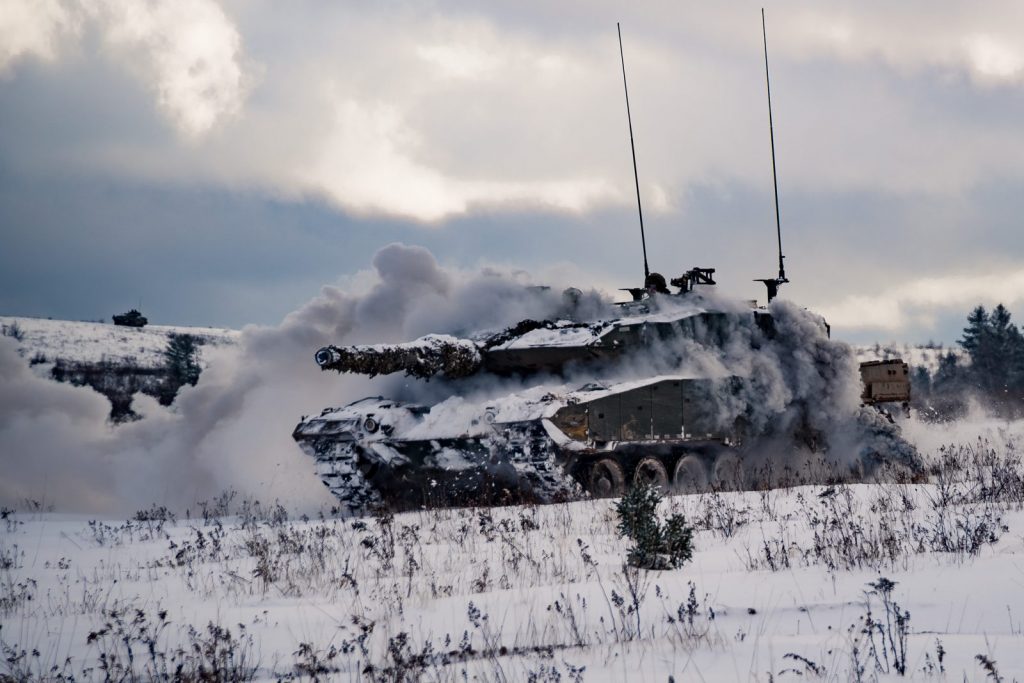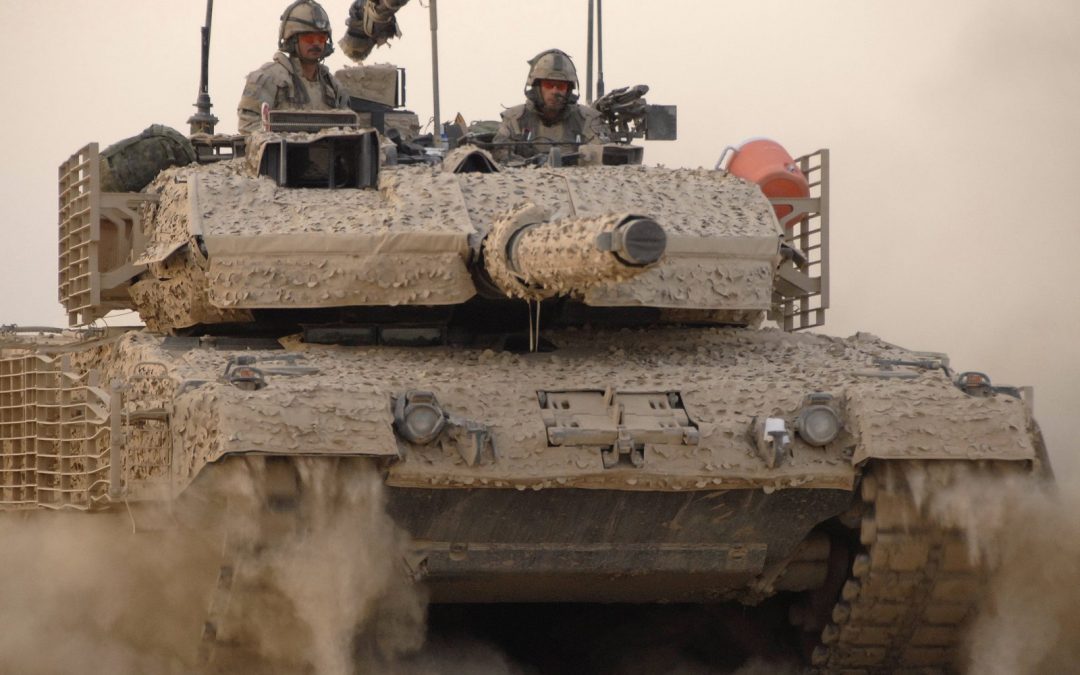By Allan Joyner
With the exception of a short period in the early 2000’s, when General Rick Hillier recommended replacing them with a wheeled gun system, main battle tanks have been seen as a key part of the Army’s combat mix.
Some suggested that tanks would be obsolete with the end of the Cold War, but recent low intensity operations have muted those comments. American combat experience in Baghdad and Canada’s experience in Afghanistan made it clear the mix of enhanced armour protection and heavy firepower only available in tracked armoured vehicles were essential to most combat operations. Tanks were here to stay.
“We are part of the brigade groups, the battle group and the combat teams and we are a force enabler to the infantry as much as they are to us,” said Lieutenant-Colonel Vincent Kirstein, commandant of the Royal Canadian Armour Corps School in Gagetown. “Armour lets people get places where they wouldn’t be able to get to, destroy things that other assets can’t destroy, and survive things that allow the combat team to do the things they need to do.”
Kirstein commanded some of the initial Leopard 2s deployed to Afghanistan in 2006, and his experience there and on operations since has underscored the continuing importance of retaining tanks, even if they are not always used. A case in point is the enhanced Forward Presence (eFP) Battle Group in Latvia.
“Because we have tanks in Canada, and because of the way the international missions in which we participate are structured, it means we don’t have to deploy our tanks,” he observed. “Right now, the Canadian commander [in Latvia] has tanks from Poland under his command and he knows how to use them effectively because he learned those skills here.”

LETHAL EFFECT
In the fall of 2006, the Lord Strathcona’s Horse (Royal Canadians) deployed to Afghanistan with 15 Leopard 1C2’s with enhanced MEXAS appliqué modular armour and they quickly demonstrated their effectiveness. These were the then latest versions of the Army’s aging Leopard 1 that had entered service in 1978.
Following an initial assessment of their performance in Afghanistan, the Army decided to upgrade to next generation Leopard 2. By September 2007, 20 Leopard 2A6’s on loan from the German Bundeswehr, upgraded to 2A6M standard of enhanced mine protection, were in service in Afghanistan, along with two Leopard 2 Büffel armoured recovery vehicles.
The procurement system caught up with events in June 2009 with the approval of the Tank Replacement Project. In the first phase, 80 surplus Leopard 2A4’s were purchased from the Netherlands. Twenty were upgraded to 2A4M standard, including modifications based on experience with earlier 2A6Ms. They were then deployed to Afghanistan in 2010.
An additional 42 A4s were inspected, repaired and overhauled to become a national training fleet. The remaining hulls were converted to armoured recovery and engineer vehicles.
The improvements to the 2A4Ms that entered service were significant. In addition to modifications that allowed the crew to operate efficiently in the heat of Afghanistan, protection and ease of operation were greatly augmented, including mine protection belly armour that brought about the “M” designation. Appliqué armour, like that installed on the most recent German Leopard 2A7+, was adapted and fitted across the glacis, hull deck and lower hull behind the suspension. And running gear and side armour were enhanced.
The tanks were also upgraded to the most current all-electric turret drive and a digital central logic and main distribution system with an improved electrical system was installed. The electric turret drive was a key change as it removed flammable hydraulic systems and replaced them with a technology that doesn’t add to the danger in the event of critical damage to the tank.
The remaining 2A4s and 2A6Ms only had an inspection, repairs as required, and minor improvements such as the driver’s viewing system. All the tanks were fitted with front and rear facing day and thermal cameras, unique Canadian equipment such as the communication system and machine guns. They were also modified to accept the tank’s mobility implements, which include dozer blades, mine plows and mine rollers.
The first phase of the Tank Replacement Project eventually brought a mix of 40 upgraded 2A4Ms and 2A6Ms and 42 2A4 “training” tanks into service – 82 Leopard 2s in all.
The second phase included building a fleet of support vehicles funded under the Force Mobility Enhancement project, a separate major capital initiative. Eighteen Leopard 2 chassis were converted to armoured engineer vehicles. The project also acquired four additional “Buffalo” armoured recovery vehicles.
Today, each of the variants are deployed in various quantities with the Lord Strathcona’s Horse in Edmonton, and the Royal Canadian Dragoons C Squadron and the Royal Canadian Armoured Corps School, both in Gagetown. One of each is also located at the Canadian Forces School of Electrical and Mechanical Engineering in Borden.

TANK LIFE EXTENSION
While the two projects provided a long-term, sustainable tank force, deployable in medium to high threat environments, until at least 2035, there remain some major concerns.
The 2A4M turret system represents the latest digital standard, an upgrade shared with the most up-to-date Leopard 2s in Germany, Denmark and Qatar. But obsolescence of several older generation 2A4 and 2A6M turret systems, designed in the 1970, is starting to impact the availability of turret components.
A procurement project expected to launch in the next two to five years will see the replacement of obsolete components, with a focus on the operational 2A6 variant as the top priority.
Plans for an essential wider life-extension project are more difficult to clarify. The 2017 defence policy offers clear direction on priorities over a 20-year horizon. The Long-Term Investment to Enhance the Canadian Armed Forces’ Capabilities section lays out priorities for the Canadian Armed Forces and identifies 10 major Army capital initiatives. However, because the Tank Replacement Project had ended relatively recently, a life-extension project did not make that list.
Nonetheless, a modernization program does fit within the wider goals of the policy to enhance the Army’s capability. As stated in Strong, Secure, Engaged, “the Canadian Army will undergo a re-capitalization of much of its land combat capabilities and its aging vehicle fleets while modernizing its command and control systems.”
Consequently, the Army is pushing ahead with its planning. Major Robert Bouchard, project director for a Tank Life Extension Project, is optimistic that another entire generation of armoured soldiers will deploy in updated versions of the current fleet of Leopards.
“The Army is in the process of identifying the project budget and timelines,” he confirmed. “There may be opportunities for international cooperation, mostly with Germany’s plan to continue upgrading its Leopard 2 fleet, such as the future 2A8 upgrade which is in the concept phase, and this should extend the Leopard 2’s life until 2050.”


Wow love that last photo!
The article failed to mention the ATTICA panoramic thermal sights that were fitted to the Leo 2A4M years ago. This was a very important lethality upgrade. Admittedly, very little has appeared in the open press on this, and since it was not part of the Tank Replacement Program, it didn’t get the visibility it deserved. But evidently the army thought the upgrade necessary to bring a portion of the fleet up to more modern standards, and saw an opportunity to do it in a cost-effective manner. Can this not be replicated with the other vehicles – the 2A6Ms at least?
CAT should take greater care when commissioning articles like this so as to thoroughly convey ALL developments to its readers.
No. Surprise is still a key factor in all forms of warfare. Good job, you may have just sank the ship.
Don’t be daft. The acquisition is a matter of public record. Our allies and any potential state adversary would know about it. No ally doing upgrades treats such capability enhancements as SECRET. (The latter are reserved for C2 systems and the like.) Look at the proposed upgrades to the UK Challenger 2 – all of which are in the public domain – and tell me that the British Army is concerned about giving away the store.
I could see Canada going the way of the UK in its attempts to upgrade or replace its existing Challenger 2 main battle tanks, where a completely new turret and gun system is grafted onto an existing hull.
In an ideal world, Canada would be designing and building its own tanks. If a country with the size and GDP of Sweden could design and build its own tanks, why can’t Canada?
Why not? Because 1) the industrial capacity doesn’t exist in this country for such a program; 2) it takes billions of dollars to bring a new tank design to the prototype stage, and; 3) billions more to acquire and maintain a new fleet. That’s money (and ambition) we just don’t have.
Some of the investment could theoretically be recovered by selling the vehicle on the open market. But there are few customers these days among allied/partner nations, and fewer still would be inclined to purchase a system that wasn’t combat-proven. Buyers would rather go for the M1 series or Leo 2. Or buy another established design such as Leclerc or the RoK’s Black Panther.
Sweden gave up on indigenous tank design when it bought the Leo 2.
One update I think that is needed is the Trophy system, at least on the 2A6’s.
Opprated one ten years ago in Afghanistan beautiful tank saved my life a few times my pops drove a Sherman tank in 1953 North Korea so tank opps run in the family like father like son
Nice response.
Our troops warrant world class tools, whether upgraded or new. Two proud sons in the reserves and their kit, too often lacking.
Not 1 Leo2A4 entered Afghanistan. I was a Wpns Tech in 2008 (2nd tour with 2A6M) and on the close out tour in 2011. I went to Germany to learn the Leo2 A6M.
Correct; the C2 MEXAS deployed, then the 2A6M CAN, only.
Nope, one troop of 2A4M deployed in 2010-2011.